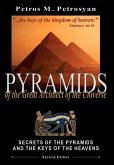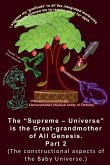The Book Is Unique of Its Kind and Has No Analog In The World. The first edition of this book is an introduction to the pyramid ciphers. The book starts with a general history of the pyramids, and then the book goes over the ciphers of pyramids proposed by the author and the general astronomy. Overall, the book is unique of its kind and is inspired by the passage from the Holy Bible in the New Testament, "...the keys of the kingdom of heaven" Matthew 16:19. The book highlights the following: 1. The pyramid is not a sepulcher of Pharaoh and the purpose of its construction was not on this plane. 2. Pyramid architectural parameters are of no importance from a cryptographic point of view. 3. The cipher essence is hidden in the pyramid's geometric form. 4. The principal model of ciphering was established, formed of 365 small pyramids and 14 levels. 5. The Bible had an immediate relation to the cipher, being simultaneously both part and clue to its decoding. 6. The numbers 365 and 14 are one of the mathematical cryptogram decoding keys.
Hinweis: Dieser Artikel kann nur an eine deutsche Lieferadresse ausgeliefert werden.
Hinweis: Dieser Artikel kann nur an eine deutsche Lieferadresse ausgeliefert werden.








